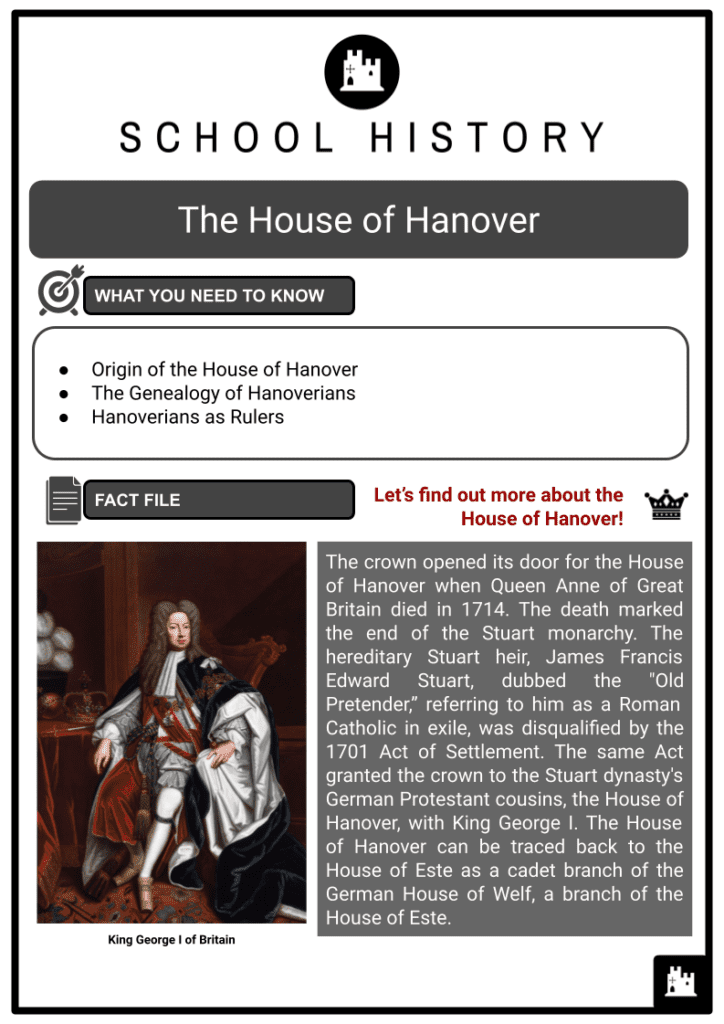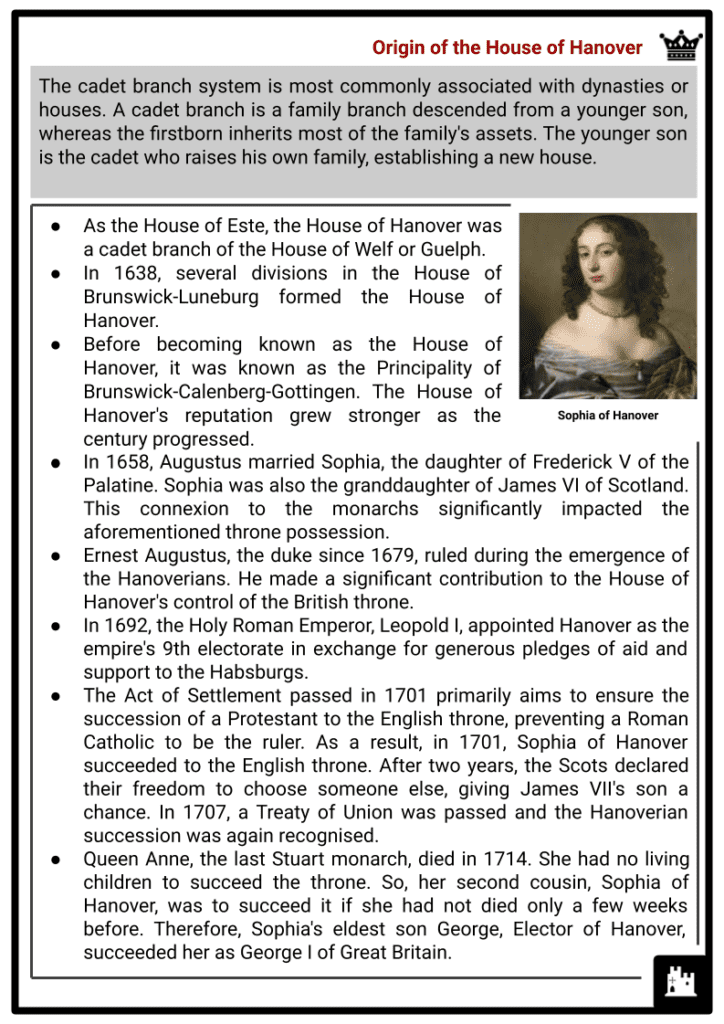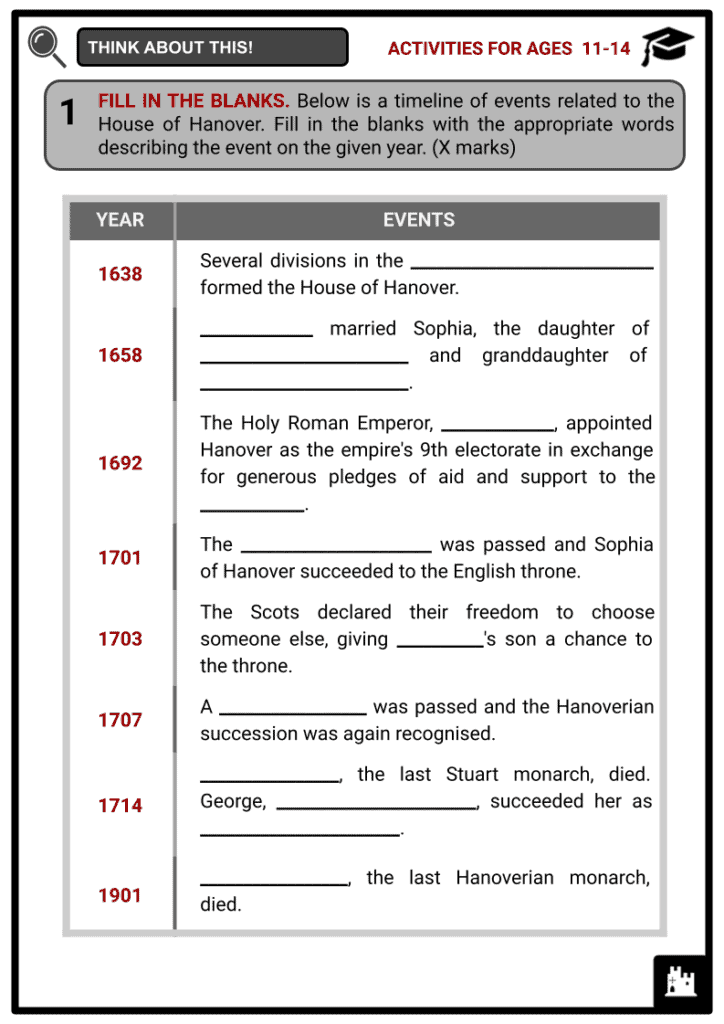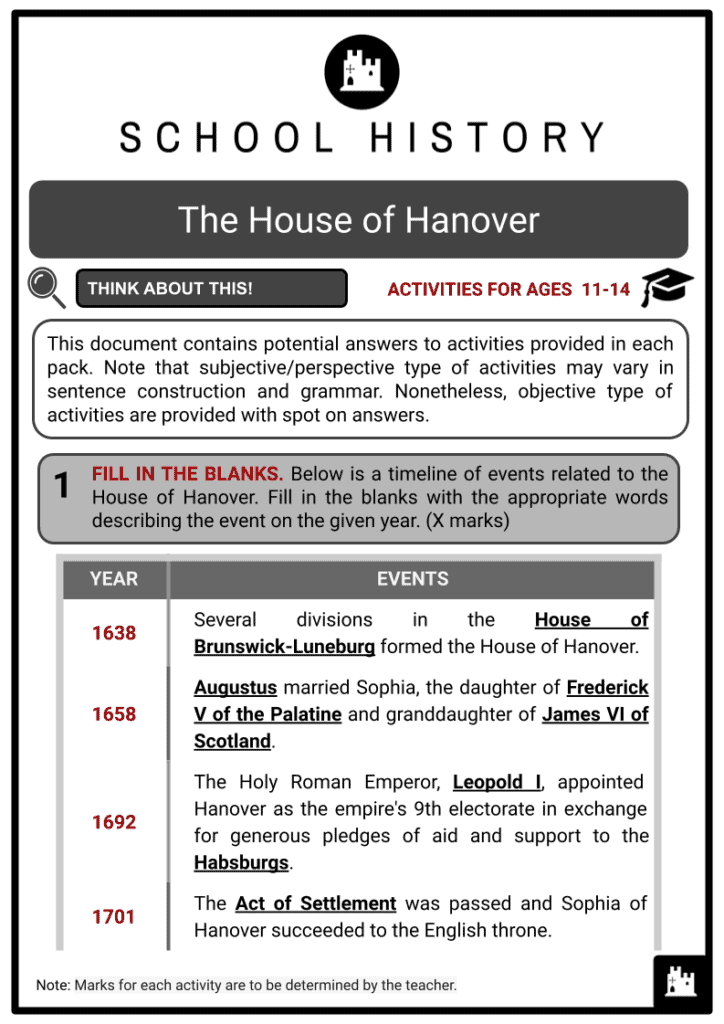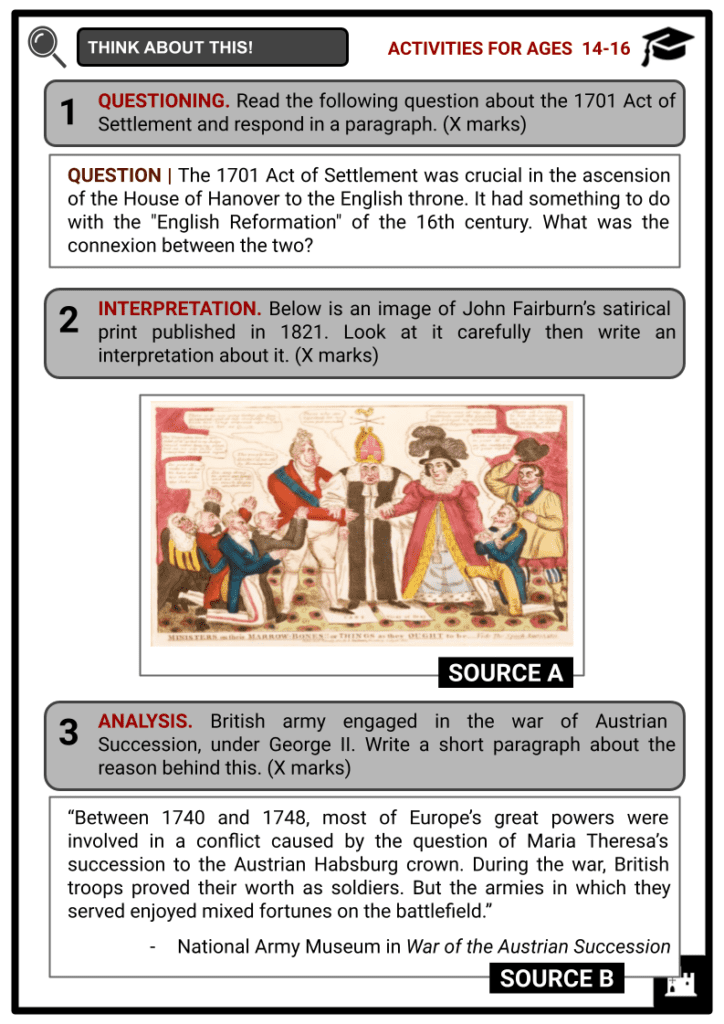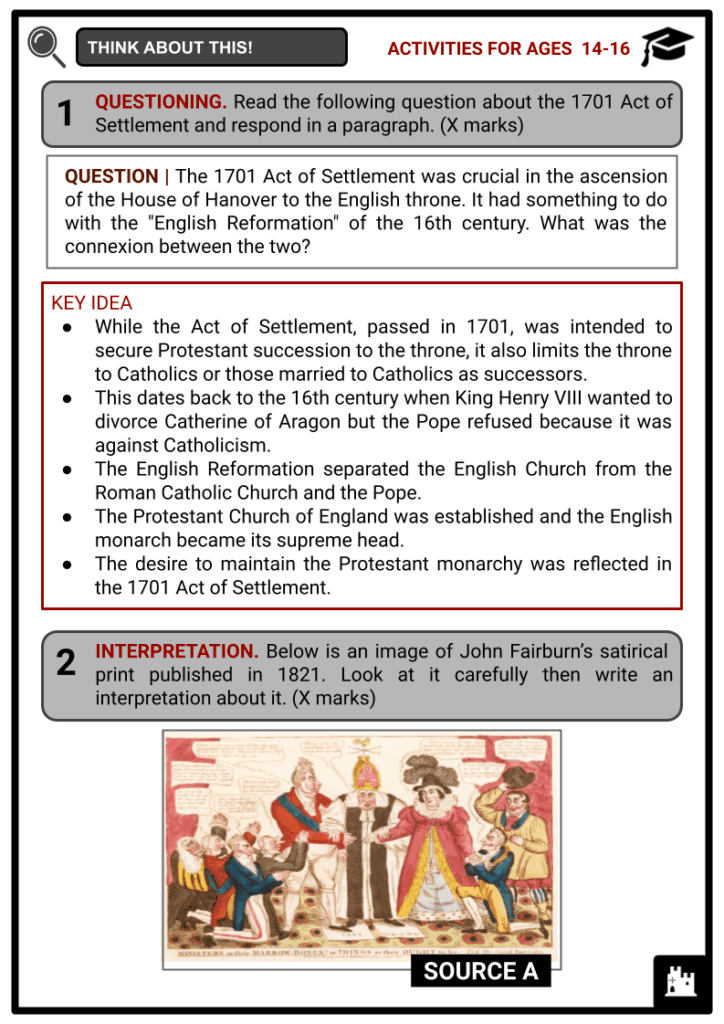The House of Hanover Worksheets
Do you want to save dozens of hours in time? Get your evenings and weekends back? Be able to teach about The House of Hanover to your students?
Our worksheet bundle includes a fact file and printable worksheets and student activities. Perfect for both the classroom and homeschooling!
Summary
- Origin of the House of Hanover
- The Genealogy of Hanoverians
- Hanoverians as Rulers
Key Facts And Information
Let’s find out more about The House of Hanover!
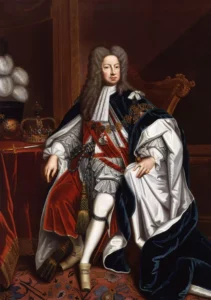
The crown opened its door for the House of Hanover when Queen Anne of Great Britain died in 1714. The death marked the end of the Stuart monarchy. The hereditary Stuart heir, James Francis Edward Stuart, dubbed the "Old Pretender,” referring to him as a Roman Catholic in exile, was disqualified by the 1701 Act of Settlement. The same Act granted the crown to the Stuart dynasty's German Protestant cousins, the House of Hanover, with King George I. The House of Hanover can be traced back to the House of Este as a cadet branch of the German House of Welf, a branch of the House of Este.
Origin of the House of Hanover
- The cadet branch system is most commonly associated with dynasties or houses. A cadet branch is a family branch descended from a younger son, whereas the firstborn inherits most of the family's assets. The younger son is the cadet who raises his own family, establishing a new house.
- As the House of Este, the House of Hanover was a cadet branch of the House of Welf or Guelph.
- In 1638, several divisions in the House of Brunswick-Luneburg formed the House of Hanover. Before becoming known as the House of Hanover, it was known as the Principality of Brunswick-Calenberg-Gottingen. The House of Hanover's reputation grew stronger as the century progressed.
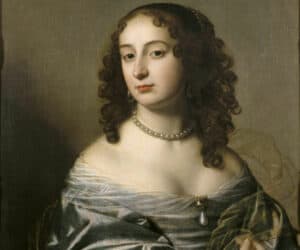
- In 1658, Augustus married Sophia, the daughter of Frederick V of the Palatine. Sophia was also the granddaughter of James VI of Scotland. This connexion to the monarchs significantly impacted the aforementioned throne possession.
- Ernest Augustus, the duke since 1679, ruled during the emergence of the Hanoverians. He made a significant contribution to the House of Hanover's control of the British throne.
- In 1692, the Holy Roman Emperor, Leopold I, appointed Hanover as the empire's 9th electorate in exchange for generous pledges of aid and support to the Habsburgs.
- The Act of Settlement passed in 1701 primarily aims to ensure the succession of a Protestant to the English throne, preventing a Roman Catholic to be the ruler. As a result, in 1701, Sophia of Hanover succeeded to the English throne. After two years, the Scots declared their freedom to choose someone else, giving James VII's son a chance. In 1707, a Treaty of Union was passed and the Hanoverian succession was again recognised.
- Queen Anne, the last Stuart monarch, died in 1714. She had no living children to succeed the throne. So, her second cousin, Sophia of Hanover, was to succeed it if she had not died only a few weeks before. Therefore, Sophia's eldest son George, Elector of Hanover, succeeded her as George I of Great Britain.
The Genealogy of Hanoverians
- After his mother's succession was passed on to him, King George I established the House of Hanover. The Hanoverians, members of the House of Hanover, reigned from 1714 until 1901, when they passed the throne to the House of Saxe-Coburg & Gotha.
- Queen Victoria, the last Hanoverian heir to the throne, married Albert of Saxe-Coburg and Gotha in 1840 at the Chapel Royal, St. James Palace in London. As a result, Albert became the Queen's Prince Consort. After his mother died, their son, King Edward VII, ascended to the throne. At this point, the House of Windsor, a cadet branch of the House of Hanover, was established.
Hanoverians as Rulers
- The House of Hanover's reign (1714 - 1901) was remarkably stable. It also brought about changes in the constitutional monarchy. During this time, the electorate grew due to the passage of the Great Reform Act. During this time, Britain conquered many territories, and by the end of its reign, the British Empire covered one-third of the globe.
George I (r. 1714 - 1727)
- Before assuming the throne, George I was a member of a foreign dynasty, which made him an unpopular king at first. He was German and couldn't communicate in English.
- There were also rumours that he was not properly treating his wife. The South Sea Company, a British joint-stock company, went bankrupt in 1720 as a result of an economic downturn.
- Nonetheless, as a king, he accomplished other things. He prioritised foreign policy, forming an alliance with France against Spain.
- By the end of his reign, a modern system of government based on a cabinet was in place.
- As a result, the power is held by Sir Robert Walpole, the prime minister at the time.
George II (r. 1727 - 1760)
- While Walpole was still in power, George II ascended to the throne.
- George II and his father have not been on good terms since 1717, but they agreed to remove Walpole from his position as Prime Minister.
- George I gave Walpole the premiership for him to recognise George II as the ruler.
- In 1742, Walpole resigned as prime minister and became the king's mentor instead.
- However, Walpole was also relieved of his duties when John Carteret took his place.
- Carteret was one of the most powerful men in the British government despite having no prior position like Walpole.
- Carteret promoted the idea that Britain was involved in the War of the Austrian Succession, which was exploited by King George II's opponents who accused him of subordinating to his German possessions.
- In 1743, George II led his troops against the French in the Battle of Dettingen.
- In 1745, the Jacobites, or supporters of the House of Stuart, launched an insurgency. No senior politician dared to oppose King George II because of Walpole.
George III (r. 1760 - 1820)
- Frederick, George II's son, died 9 years before his father's reign ended. As a result, his grandson, George III, took his place.
- Unlike his grandfather and great grandfather, George III was born in the United Kingdom rather than Germany and spoke English as his first language.
- At the start of George III's reign, politics and finance were in disarray. Foreign policy and relations, on the other hand, were a success.
- In 1763, Britain broke free from French control and established dominance over Northern America and India.
- After Britain attempted to levy taxes on American colonists, war broke out in 1775.
- Two years later, King George III directed that the American settlement be extended to prevent rebellions.
- During King George III's reign, the French Revolution and the rise of Napoleonic France both occurred, causing more wars in Britain.
- When Britain was at war, King George III suffered from several bouts of acute mania.
- Napoleon was defeated at the Battle of Waterloo in 1815, but King George already had lost his mental stability. Some speculate that the king's insanity was caused by porphyria, a blood disease.
- Recent studies on the king's hair revealed high levels of arsenic, which could indicate poisonous substances caused the madness.
George IV (r. 1820 - 1830)
- George IV was a prince regent from 1811 until his father died in 1820, when he became king as heir to the throne.
- He was best known for his luxurious lifestyle, which caused his father to reconsider passing the throne to him. Another fact that upsetted his father is that George IV married his cousin, Caroline, to persuade the British Parliament to pay his debt.
- On the contrary, some people admired George IV because he was an arts patron. The Marble Arch, Regent Street, and the Royal Pavilion were all designed by John Nash, who received royal patronage.
- During his reign, not much happened. Because his only child, Charlotte, died before he became king, the succession passed on to his brother.
William IV (r. 1830 - 1837)
- During his seven years in power, the most notable contribution he made was the passage of the Reform Act of 1832, despite his opposition to parliamentary reform because it would reduce the monarch's power over the government.
- In 1837, King William IV died. Because all of his legitimate children had passed, his niece, Victoria, ascended to the throne.
Queen Victoria (r. 1837 - 1901)
- Victoria is the second-longest reigning monarch, having ruled over the United Kingdom for nearly 64 years.
- The Victorian Era, Queen Victoria's reigning period, brought about significant changes in the British Empire, including its expansion.
- During the Victorian era, the Second Industrial Revolution, a period of rapid technological development, began.
- After the East India Company's governance was transferred to the British Crown in 1858, Victoria was dubbed the "Empress of India" in 1876.
- Queen Victoria's reign came to an end when she died in 1901.
- The House of Hanover was an important figure in British history.
- During the dynasty's nearly 200-year reign, Great Britain evolved from a dominant power in Europe to a world superpower.
- At the same time, the current relationship between the British monarchy and the government was established during the reign of the Hanoverian monarchs.
- While monarchs sought to retain political power, their governments sought to limit it.
- In the end, the British monarchy was reduced from a political to a ceremonial institution.

